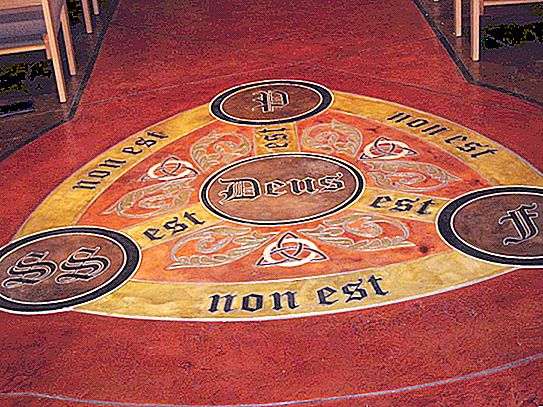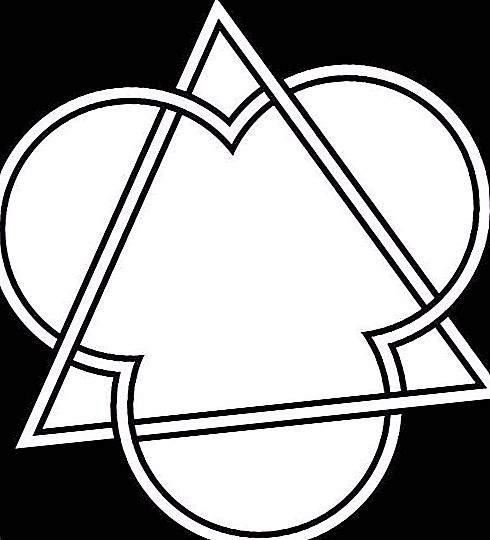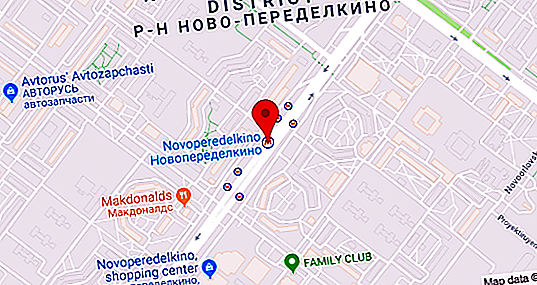The symbol of trinity is the image of three identical or similar elements located at an equal distance from each other and forming either a triangular figure or a circle. As a rule, these signs contain a deep spiritual meaning, and often they are credited with miraculous mystical properties. They also mean the unity of the three qualities, phenomena, states, hypostases into an integral entity. The article presents a description and photo of the symbol of the trinity that makes up the triangle.
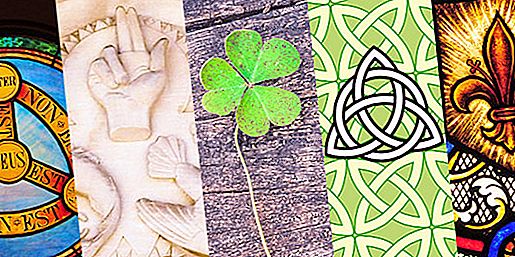
Ancient origin
Some signs appeared long before our era, and it is now almost impossible to pinpoint their original meaning. The most ancient symbol of the trinity was the image of the triangle, which can be observed in the form of cutouts on the bone and drawings on the first stone age ceramics. Over time, circles, dots, spirals, and other shapes appeared that made up a circle or triangle. Such drawings were not always of any importance, most often they were just an ornament. Sometimes such images marked places of worship and burial.
With the development of rich mythology and the organized religion of the ancient Egyptians, Sumerians, Greeks, Celts, Iranian and other peoples, some signs became sacred. They symbolized the triads of gods or the hypostasis of one deity, its three qualities and manifestations, designated the higher, human, underground world, the process from birth to death, as well as other ideas about the universe.
In the period of the formation of ancient philosophy, astronomy, and geometry, the signs of the triads acquired additional significance. The whole, consisting of three parts, meant human qualities, states, actions, natural phenomena, elements, celestial objects, temporal relationships, types of art, mathematical functions, and other concepts. Visual variants of intersecting elements of triangular shapes and combining them with other geometric shapes have appeared.
Middle Ages
The early Christians depicted the image of God as a triangle, the images of which can be seen in Roman catacombs and funerary plates. After the First Ecumenical Council (325), at which the formula of religion was approved, the church adapted some of the ancient signs as Christian symbols. Until the tenth century, the image of the three hypostases (faces) of the one God, namely the Father, the Son, the Holy Spirit in human images, was not accepted. Therefore, such figures as a triquetre, a stylized shamrock, a triskelion, a simple and formed from various elements triangle, as well as other signs began to mark the Holy Trinity. Some ancient symbol of the trinity became a decorative element of temple architecture and a richly illustrated bible. Similar signs appeared on frescoes and in religious painting, as ornaments and protective amulets on knight's shields, weapons, armor, as well as on the coat of arms.
19th Century Occultism
In the middle of the century before last, interest in philosophia occulta was widespread throughout Europe and many areas of North America, becoming a fairly fashionable phenomenon in the middle and higher circles of society. With the development of science and technology, developments have appeared that bring the ideas of esotericism to a scientific basis. Many theoretical works have been written, many books and magazines have been published in various areas of occultism. Since in the esoteric tradition one of the main principles is the submission of all essences to the law of trinity, the symbol of the triad in "secret teachings" is endowed with special, mystical significance. In occult publications of the 19th century, such images are interpreted in terms of their deep meaning in esotericism, as well as the sacred role of Western and Eastern religious systems.
Triangle
Since ancient times, the figure has been correlated with fire, mountain, stone, peak, reflecting the connection of the earthly and mountainous world. The figure turned upside down personified the most ancient Great Goddess, the bearer of heavenly waters. Depending on the position of the peak, the image means feminine or masculine, and two combined figures symbolize creation and creative power. The inverted triangle was likened to the cup and the Holy Grail, with the top up - to the heart.
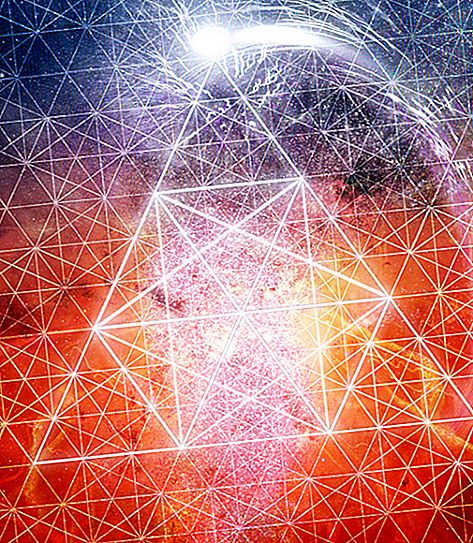
As the first symbol of the trinity, the figure most often reflected the sky, the earth and between them a person or a divine, human, animal essence. The triangle also denoted the world of the dead, living and higher spheres.
- In the ancient Egyptians, the vertical side of the triangle was identified with a man (beginning), horizontal - with a woman (middle, storage), hypotenuse - with offspring (completion). In the world of the gods, these foundations of procreation were represented by the triad of Osiris, Isis, and Horus. The Egyptians considered the nature of all things and the perfection the number three contained in the triangle, the sacred aspect ratio and hypotenuse of which corresponded to a ratio of 3: 4: 5.
- In ancient Athens, the right triangle was dedicated to the goddess of knowledge and wisdom Athena, and also symbolized the cosmos, creation, absolute and was considered a divine creation. Pythagorean Tetractis, containing ten points and nine equilateral triangles, was identified with the Great Unified Being, containing everything else.
- In Christianity, the figure symbolizes the Trinity and, as a triangular halo, is an attribute of God the Father. The so-called shield of the Holy Trinity in the form of an inverted triangle is often part of the stained glass windows of Gothic cathedrals. During the Renaissance, the triangle with the divine all-seeing Eye was depicted as a sign of higher conduct, and later became part of Masonic symbolism. The eye of God, depicted in a triangle, is also a symbol of Jehovah in Judaism and is present in the cult art of ancient Egypt.
There are other figures forming three equal sides. The period and places of their origin differ, but in Christianity the meaning of the symbol of the trinity for these signs remains similar - they all identify the Holy Trinity.
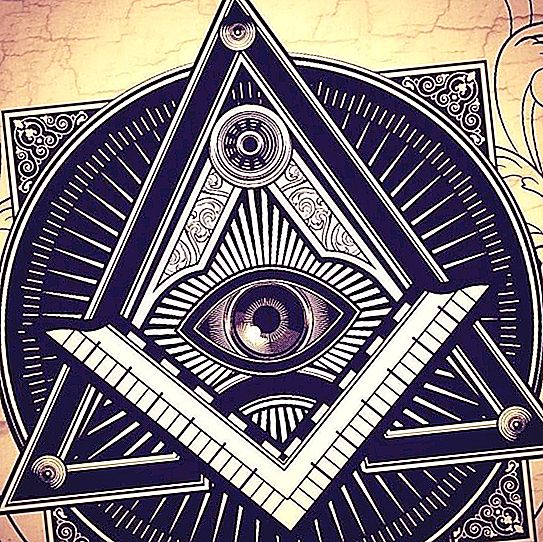
Christian Triangle Options
In the religious symbolism of the Middle Ages, many varieties of such figures appeared:
- The triangle in combination with the cross symbolized the death on the cross of Jesus for human sins, the resurrection of him by God the Father, the repentance of Christians and the indulgence of the Holy Spirit.
- The three fish that make up the triangle meant: Jesus Christ, the Son of God, the Savior. They also marked the Trinity.
- A triangle containing the Greek letters Omicron, Omega and Nu. These letters mean the words εγω ειμι ο ων, spoken by God to Moses from a burning bush (Exodus 3:14), which translate as "I Am Jehovah." Literally, the phrase was taken from the Septuagint, an ancient Greek translation of the Old Testament.
- Three figures of running rabbits create two triangles, internal and external. The symbol was often present as a relief element of architecture and wooden details. The sign also marks the Triune God. Such an image is found in the wall paintings of ancient Egypt and, perhaps, then symbolized a man, a woman, offspring.
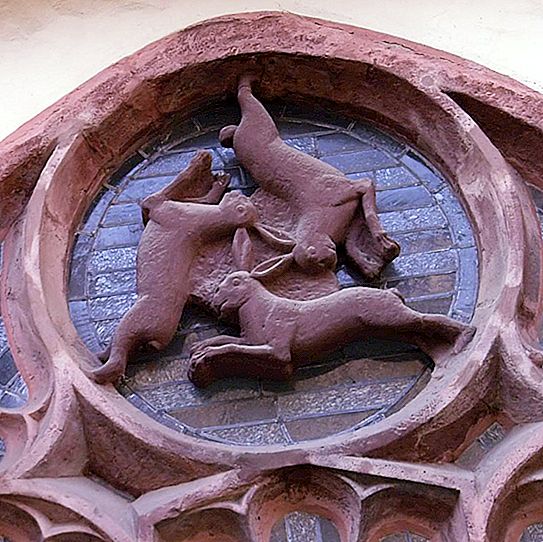
Triquetre
It is believed that this beautiful balanced symbol appeared originally in Celtic culture and denoted three positions of the sun in the sky: sunrise, zenith, sunset. The current name of the figure comes from two Latin words, tri and quetrus, which means "triangular". The symbol has another name - a triple Celtic knot. The sign was very common among the northern European population, and it can often be seen on Celtic crosses. In these peoples, the symbol was associated with the god Manannan, among the Scandinavians - with Thor.

Later in the tenth century, the sign as an ornamental element began to appear in the culture of the Baltic Slavs - the Vikings. From them, the image fell on the lands of Russia, where the triquetra was extremely rare and most likely remained just a beautiful pattern. If we talk about the meaning of the symbol of trinity among the Slavs, then in Russia such images were practically not used. Common forms in Russian ancient Slavic ornament and sacred symbolism are a cross, square, circle (Kolovrat). The symbol of the Divine Trinity appeared after the baptism of Russia.
In medieval Europe, the triquetre became the Christian symbol of the Trinity, as well as a popular element of architecture and artistic decor. In the beautifully illustrated book of Kells by the Irish monks in the early ninth century, the tricker motif is repeated many times. The figure is single, double, can be combined with the outer and inner circle and triangle.
Banner of Peace
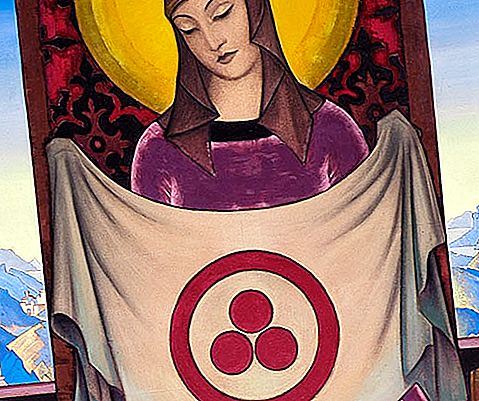
A symbol of three circles or dots has a very wide range of interpretations, largely similar to an equilateral triangle. The most famous variant of the sign was the Banner of Peace, the design of which was developed by the Russian artist, philosopher and writer Roerich Nikolai Konstantinovich for the international Covenant for the protection of cultural heritage in 1935. The description and purpose of using the symbol in the official contract is as follows:
A distinctive flag (a red circle with three circles in the middle on a white background) may be used to designate the monuments and institutions referred to in Article I in accordance with the model attached to this agreement.
(Treaty on the Protection of Artistic and Scientific Institutions and Historical Monuments (Roerich Pact)).
About how widespread the sign is in the religious culture of different nations and what inspired the artist to the ideological and visual content of the Banner of Peace, Roerich himself says in his letters and notes published in the two-volume collection “Diary Sheets”:
What could be more ancient and authentic than the Byzantine concept, dating back centuries to the first generalized Christianity and so beautifully embodied in Rublev’s icon of the Holy Life-Giving Trinity of the Holy Trinity Sergius Lavra. It is this symbol - the symbol of ancient Christianity, illuminated for us by the name of St. Sergius, our sign told me, the meaning of which is expressed in the attached picture, preserving all the elements and their locations, according to Rublev’s icon. ”
“The Sign of the Banner also appeared in the Temple of Heaven. Tamga Tamerlane consists of the same sign. The sign of the three treasures is widely known in many countries of the East. On the chest of the Tibetan can be seen a large brooch, representing a sign. We see the same brooches in the Caucasian finds, and in Scandinavia. The Strasbourg Madonna has this sign in the same way as the saints of Spain. The icons of St. Sergius and the Miracle Worker Nicholas have the same sign. On the chest of Christ, in the famous painting of Memling, the sign is imprinted in the form of a large breast brooch. When we sort through the sacred images of Byzantium, Rome, the same sign connects the Holy Images all over the world.
Tripol
The name of the figure means trefoil and comes from the Latin trifolium. This symbol of the trinity of the Lord appeared around the tenth century. It reached its popularity in the XIII and XIV centuries, when it was often used in architecture and stained glass. This is a graphical form consisting of the contour of three intersecting rings. The term is often applied to other three-fold characters. It is curious that the logo of the famous Adidas concern also contains a stylized shamrock.

